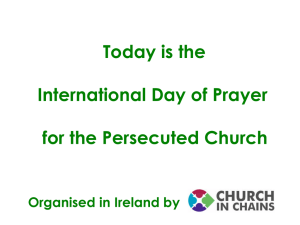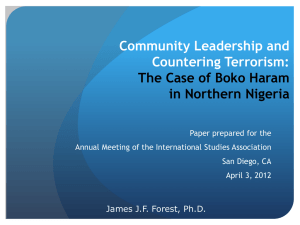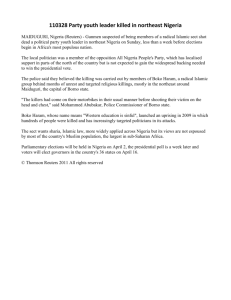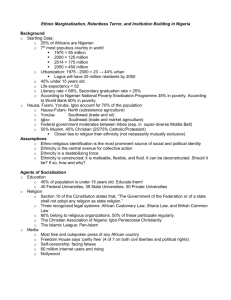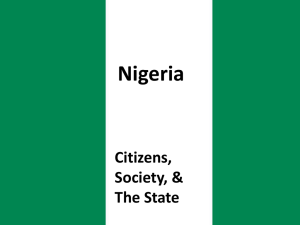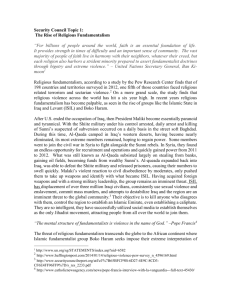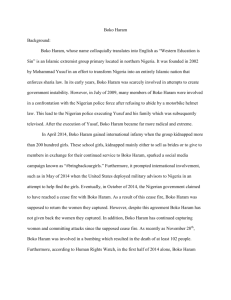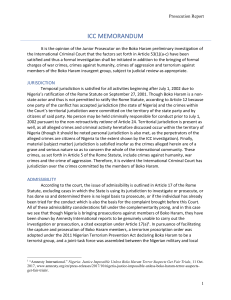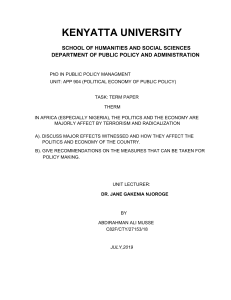Boko Haram - World Religion News
advertisement
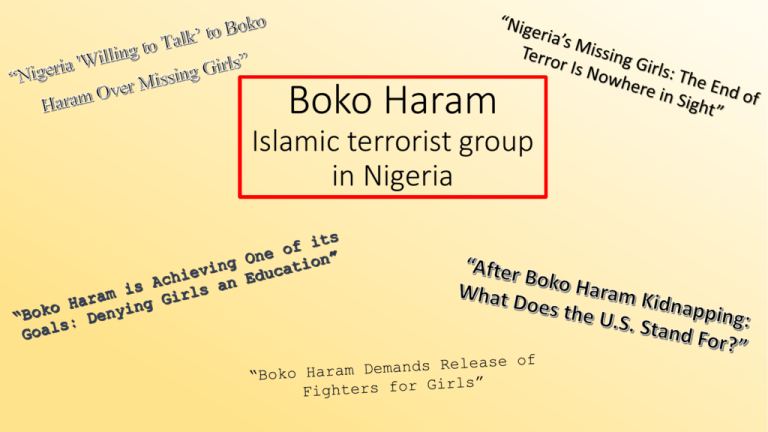
Boko Haram Islamic terrorist group in Nigeria History of Religious Controversy in Nigeria “The abduction centers around the age-old strife between Muslims and Christians. Most of the Muslims in the north did not have an opportunity to get an education, whereas the people in the south did because that's where the British settled.” -Emanuel E. Nneji Associate professor of communications Worcester State University The problem exploded after the last Muslim president, Umaru Yar'Adua, died in May 2010, during his first term, and Mr. Jonathan, a Christian, who was the vice president took over as president. Mr. Nneji said Muslims felt that another Muslim should have finished out the term of the president who died. It was around this time that the small group of Islamist militants stepped up their presence. The word Boko Haram means Western or non-Islamic education is a sin. History of Boko Haram Multiple attacks by Boko Haram Number of casualties by Boko Haram attacks His most recent attack? An abduction of over 200 girls. The group especially opposes the education of women. Under its version of Sharia law, women should be at home raising children and looking after their husbands, not at school learning to read and write. CNN News “Dozens of gunmen stormed the Government Girls Secondary School in Chibok, about 130 km (81 miles) west of Maiduguri, on Monday night as the students slept in their dormitories, officials said. They engaged the soldiers guarding the school in a lengthy gun battle and then herded the girls onto vehicles.” CNN News Reporting was more for attention purposes and promoting their news. First report: April 15th “After the kidnapping of more than 200 schoolgirls from a school in northern Nigeria, the whole world's attention was focused on one village - Chibok -- but CNN was the first news organization to send a team to the scene of the atrocity.” “The militant Islamist group has bombed schools, churches and mosques; kidnapped women and children; and assassinated politicians and religious leaders. It was unlikely they would welcome Western journalists, and those accompanying us, with open arms.” http://www.cnn.com/2014/05/12/world/africa/nigeria-boko-haram-chibok-journey/?hpt=hp_c1 http://www.cnn.com/2014/04/15/world/africa/nigeria-girls-abducted/index.html?iref=allsearch “'Boosting spirits' Mr Turaki - who is special duties minister and chairman of a committee set up by President Goodluck Jonathan to find ways of reaching agreement with Boko Haram - said that Shekau should send people he trusted to meet the standing committee on reconciliation.” BBC News BBC Reporting was informational and supported by credible sources. First report: April 15th “A team of about 30 US experts members of the FBI and defense and state departments - is in Nigeria to help with the search. The UK, France and China also have teams on the ground in Nigeria and an Israeli counterterrorism team is on its way. Nigerian Chief of Defense Staff Alex Badeh welcomed such support and described the relationship between his country and the US as ‘mutual and strategic.” http://www.bbc.com/news/world-africa-27398640 http://www.bbc.com/news/world-africa-27037181 The Washington Post “Here’s what you need to know about the kidnapped Nigerian girls, Boko Haram and how the U.S. is getting involved” Who was kidnapped? How were they abducted? Who took them? How has the U.S. government reacted? Have the girls been seen since they were abducted? What has the Boko Haram group done in the past? “The kidnapping of hundreds of Nigerian schoolgirls sparked an international outcry, caused protests in the United States and across the world and drew help from the U.S. as well as other countries.” Reporting was very informational and answered commonly asked questions. First report: April 15th “Suspected Muslim extremists kidnapped about 100 girls Tuesday from a school in northeastern Nigeria, less than a day after militants bombed a bus station and killed 75 people in the capital — a surge in violence that raised new doubts about the military’s ability to contain an Islamist uprising.” http://www.washingtonpost.com/news/post-nation/wp/2014/05/13/heres-what-you-need-toknow-about-the-kidnapped-nigerian-girls-boko-haram-and-how-the-u-s-is-getting-involved/ President of Nigeria The girls' abduction and President Goodluck Jonathan's refusal for weeks to accept help from the U.S. and other countries have caused outrage throughout the world, “Local Nigerians say they are angry and disappointed about the way the Nigerian government has handled the abduction of some 300 schoolgirls last month, but they are not surprised.” “I believe that the kidnap of these girls will be the beginning of the end of terror in Nigeria.” — Nigerian President Goodluck Jonathan http://www.telegram.com/article/20140513/NEWS/305139938/1116 Social Media #BringBackOurGirls seeks justice through social media The campaign took off, achieving over one million tweets on Twitter by May 7 and becoming one of Facebook’s top trending topics. “I realized recently that a hashtag is like a call,” said Ramaa Mosley, a Los Angeles director heavily involved in the campaign. “It’s like a call out to the world and it’s also an amalgamation so you can pull together information, put that information in and get information back.” See more at: https://twitter.com/search?q=%23BringBackOurGirls&src=tyah Social Media See more at: https://www.facebook.com/profile.php?id=100 008316073313&fref=ts https://www.facebook.com/bringbackourgirls A Facebook page compiling information about the story and offering suggestions to viewers about ways to take action has gathered more than 185 million likes. Analysis Through the use of media, I have shown how different sources covered the terrorist attacks by Boko Haram in Nigeria. This also leaves room for interpretation for the viewer as I present actual quotes, pictures, and videos from the sources. In addition, I used the first reports each source gave so the content would theoretically be the same and thus the differences in reporting style would be evident. To orient the audience, I began my project with background knowledge about the controversies that have taken place in Nigeria as a result of religion. The north is primarily Muslim and military based while the south is primarily Christian and has opportunities for education. Around 2010, a group of Islamist militants, called Boko Haram, emerged. Boko Haram translates to Western or non-Islamic education is a sin. The next slide contains two maps of previous attacks by Boko Haram. The viewer is able to obtain a lot of information from the maps. The first displays where Nigeria is in the world and what countries surround it. The map also shows where the highest concentration of attacks by Boko Haram has been. In addition, the location of the latest attacks are explained. The second map displays the number of casualties by region from Boko Haram attacks. After explaining the history of the country and the militant group, I focused on the most recent attack; an abduction of over 200 school girls. The video was from the first source I examined- CNN. The video displayed the leader of Boko Haram confirming he abducted the girls and is planning on selling them. Along with the quotes from their news articles, the CNN video clearly was playing on peoples’ emotions. There is clear disbelief and bias in the voice of the reporter. The quotes also used attention-seeking language. For example, “the gunmen stormed,” “as the students slept in their dormitories,” and “herded the girls onto vehicles.” In addition, CNN almost prided themselves on how they obtained the news. This was clear when they said, “But CNN was the first news organization to send a team to the scene of the atrocity” and “It was unlikely they would welcome Western journalists, and those accompanying us, with open arms." BBC News was the next source I examined. While analyzing BBC, I noticed their news contained credible sources like the Nigerian Chief of Defense Staff and the special duties minister and chairman of the agreement committee. While their reporting style seemed to be more factual, they supported their stories with profound pictures. I also looked at how Tkhe Washington Post covered the news. The reporters seemed to focus on important questions their viewers wanted or needed to know. The Washington Post also focused on what was being done about the attack and assistance from other countries. However, the quotes from their articles use harsh language for a sensitive topic such as “extremists, bombed, killed, and uprising.” The Washington Post also included a picture of the mothers to show how this abduction is effecting the families. Next, I decided to examine what the president had to say. I wanted to hear directly from him more than going through another source so I viewed videos from this talks. The first video is President Goodluck Jonathan’s first speech after the abduction. He tried to keep the hope of his country high as he promised he would find the girls. The second video is after receiving help from other countries. The quote found on this page, while bias, exemplifies the frustration of Nigerian’s citizens with their government. A huge source this attack has had an impact on is social media. The first social media slide focuses on Twitter. A campaign called Bring Back Our Girls has magnified through the use of Twitter. The abduction occurred April 14th and by May 7th the campaign received over one million tweets. The biggest impact and possibly a controversial one is Michelle Obama’s tweet using the #BringBackOurGirls. This surely gained lots of attention around the world. Lastly, I looked to Facebook on the attack. The Facebook page Bring Back Our Girls has received more than 185 million likes. On this page there is the latest information about the abduction, ways to rally for support, and pictures of rallies that have happened around the world. Two pictures I used were from rallies held in Panama and Paris. Lastly, I provided a picture of Malala Yousafzai holding up a sign supporting the Bring Back Our Girls campaign. This is a powerful picture as she is known for her activism for women’s right to education. In conclusion, throughout this project my goal was to present media from different sources. In doing so I allowed the audience to interpret the multiple styles and tactics used by media to gain attention. Whether its promoting their news, reveal “shocking” news, or supporting the victims, media sources portray the same event in multiple way depending on what they are trying to accomplish.
